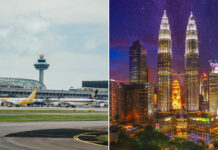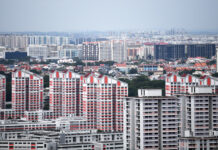SINGAPORE: Every time you go to the toilet, your waste enters the sewers as used water, gets treated at a water reclamation plant, then processed into NEWater or released into the sea.
The treatment process also produces sludge, a mud-like mixture of solid and liquid bits that goes into the incinerator and then dumped in the landfill.
Sounds simple enough, but there’s a problem: It’s not just a bit of mud.
Singapore consumes 430 million gallons of water a day (mgd), enough to fill 782 Olympic-sized swimming pools, and generates 300,000 tonnes of sludge a year, equivalent to the weight of 3,000 buses.
These figures are not about to go down. By 2060, when Singapore is set to use twice the amount of water it does now, it will generate 600,000 tonnes of sludge annually.
This presents a challenge, as Semakau Landfill is projected to run out of space by 2035 at the current rate waste is being generated and burnt.
Enter national water agency PUB, which is trying to recycle more of the sludge into biogas, an important source of energy.
PUB is already turning some of the sludge into biogas, which means its four water reclamation plants are 25 per cent energy self-sufficient.
This is because its plants have digestors that convert the organic matter in sludge into biogas, which can in turn power generators.
Pump shafts in the Deep Tunnel Sewerage Sytem pumping station at the Changi Water Reclamation Plant in 2009. (Photo: Don Wong / TODAY)
But within the next decade, PUB wants its plants to be fully energy self-sufficient. This means turning even more sludge into biogas through technological innovations.
One way is through a thermal hydrolysis process (THP), which pre-treats sludge using high temperature and pressure to improve its breakdown rate in digestors. This allows more organic content to be converted to biogas.
PUB is testing this technology at a demonstration plant at the Jurong Water Reclamation Plant. The demonstration plant can treat up to 70 tonnes of sludge a day.
The agency is also testing a “novel combination” of processes, including a biologically enhanced treatment facility and energy-efficient membrane bioreactor (MBR) that helps shorten the treatment process, reduce energy use and maximise biogas production.
This combination is being validated at the Ulu Pandan wastewater treatment demonstration plant, which uses 40 per cent less energy than a typical plant.
WHAT’S THE BIG DEAL?
Besides extending landfill lifespans, how will reducing the energy and waste footprint of treating used water benefit people?
As PUB explains, used water treatment is the “backbone” of NEWater production, which currently supplies up to 40 per cent of Singapore’s water demand. By 2060, NEWater will supply up to 55 per cent.
File photo of NEWater plant. (Photo: PUB)
The same goes for desalinated water, another national tap that will be stretched by rising demand.
“Meeting future water demand with today’s technologies will see PUB’s energy footprint quadruple to 4,000GWh/year and the amount of sludge generated double to over 600,000 tonnes a year by 2060,” PUB said on Tuesday (Jul 3). “This is unsustainable and can only be overcome by leveraging technological innovations.”
That energy footprint would have been enough to power 686,000 5-room Housing and Development Board flats for a month.
“The price of energy is going to go up,” PUB’s assistant chief executive (future systems and technology) Harry Seah said. “If you don’t do anything today, the cost of producing water is going to go up.”
WATER PRICES
When asked if the technological innovations would help keep water prices stable, Mr Seah said “we do our part through efficiency to drag it (out) as long as possible, that’s the best I can do”.
Since July, the price of water has gone up 30 per cent following a two-step increase. The hike was in line with the rising costs of producing water.
File photo of tap water. (Photo: AFP/Yoshikazu Tsuno)
“Whether the price will go up, I don’t know, but we can try our best to make our water affordable to the public,” he added, highlighting that it would also depend on other factors like manpower.
“Basically, we have to look at it from the point of view of sustainability, besides dollar and cents.”
INVESTING IN R&D
And so PUB’s target is clear: Produce double the amount of water to meet 2060 demand, but with the same energy and waste footprint.
To do this, it has – together with partners – invested an average of S$30 million a year in water technology research and development (R&D), enabling technologies like THP and MBR to progress beyond proof-of-concept.
The electro-deionisation process that separates salt from seawater takes place in these modules. (Photo: Aqil Haziq Mahmud)
For instance in desalination, PUB has invested in electro-deionisation (EDI) technology, which uses an electric field to extract dissolved salts from seawater.
In contrast, desalination is currently done by reverse osmosis (RO), which involves pushing seawater through membranes that filter out salts and impurities.
The fact that EDI revolves around extracting a small component out of a larger base, as opposed to other way round in RO, means it consumes less energy.
The electro-desalination facility in Tuas is being used to demonstrate that the technology works, before it is transferred to the new Tuas Desalination Plant. (Photo: Aqil Haziq Mahmud)
While current desalination technology uses 3.5kWh/m3, an EDI demonstration plant in Tuas is consuming 2.4kWh/m3 to process 3,800m3 of water a day.
The target is to bring this down to 1.8kWh/m3 by the end of the year, while there are also plans to further validate the technology at 10,000m3 of water a day at the new Tuas Desalination Plant.
Beyond EDI, PUB is pouring resources into other water technologies ranging from electrical fields to cell membranes, all in the name of reducing energy consumption.
REDUCING WATER DEMAND
While these bode well for boosting the efficiency of water supply, Mr Seah insisted that managing water demand is equally important.
“Even when I say water demand is doubled, I’m going to try ways and means to impede the rate of increase of the demand,” he said.
Mr Seah said the PUB has been “quite aggressive” in encouraging industries to recycle their processed water, in a bid to reduce demand by 3mgd every year.
A family living in Punggol testing out the new smart water meters that aim to drive water efficiency within households. (Photo: Facebook/PUB, Singapore’s National Water Agency)
As for consumers, Mr Seah said the automated meter reading (AMR) project will help PUB monitor efficiency and energy savings, as well as calibrate demand and supply.
In 2016, PUB piloted the project to provide some 500 households in Punggol with “timely” information on water consumption.
“Most important, it is to change the behaviour of consumption,” Mr Seah added. “If you turn it into a behavioural change, if a member of the public thinks it’s the last drop, then you will be very careful using water.”




